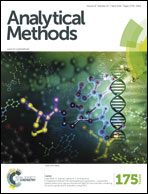Reorganization energy and Stokes shift calculations from spectral data as new efficient approaches in distinguishing the end point of micellization/aggregation†
Abstract
Critical micellar concentration (CMC) is an important parameter which indicates the matured associated state of amphiphilic molecules. The present work demonstrates a new, accurate, and generalized method for the determination of the critical micellar concentration (CMC) based on the estimation of the reorganization energy (RE) and Stokes shift of fluorescent probes placed inside micellar aggregates. With increasing concentration of surfactant, the fluorophore is well portioned in the micellar environment. The change in the magnitude of the Stokes shift and reorganization energy with respect to bulk water is a result of the formation of aggregates from surfactant monomers and there is a substantial change of RE in the vicinity of the CMC like what is observed with various other physical parameters during micellization. CMC values determined from both Stokes shift calculation and reorganization energy estimations are comparable with those previously reported in the literature. However, we demonstrate that reorganization energy calculation provides improved consistency and is more user-friendly than that estimated from Stokes shift measurements.


 Please wait while we load your content...
Please wait while we load your content...